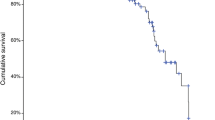Abstract
Purpose
The impact of positive surgical margins (PSM) on biochemical recurrence (BCR) has been heavily debated in laparoscopic radical prostatectomy (LRP). The aim of this study was to investigate the impact of PSM on BCR following LRP in patients with extended follow-up.
Methods
Retrospective chart review of 1,845 patients who underwent LRP from 1999 to 2007. Predictors of PSM and BCR were identified utilizing univariate and multivariable logistic and Cox regression analyses, respectively.
Results
Five hundred and thirty-seven patients (29.1 %) had a PSM. Median postoperative follow-up was 56 months. 10-year BCR-free survival was 59.2 and 82.9 % for patients with and without PSM, respectively (p < 0.0001). Clinical stage T2 (OR 1.66; CI 1.23–2.25; p = 0.001), a biopsy Gleason sum > 7 (OR 1.84; CI 1.06–3.18; p = 0.031) and preoperative prostate-specific antigen (PSA) levels of 10–20 ng/mL (OR 1.58; CI 1.12–2.23; p = 0.010) and >20 ng/mL (OR 6.82; CI 3.51–13.27; p < 0.0001) were independent predictors of PSM. Prostate size was inversely associated with PSM (OR 0.99; CI 0.98–1.00; p = 0.002). On multivariable analysis, LRP Gleason score of 7 (HR 2.45; CI 1.67–3.40; p < 0.0001) and >7 (HR 4.76; CI 3.15–7.19; p < 0.0001), PSM (HR 1.49; CI 1.14–2.00; p = 0.003), advanced pathological stages (p < 0.001), and PSA 10–20 ng/mL (HR 1.46; CI 1.13–1.89; p = 0.004) were independent predictors of BCR.
Conclusions
We demonstrated the independent predictive value of PSM for BCR in our LRP cohort with extended follow-up. Our results could potentially be transferred to robotic RP, in which long-term follow-up is lacking.

Similar content being viewed by others
References
Schuessler WW, Schulam PG, Clayman RV et al (1997) Laparoscopic radical prostatectomy: initial short-term experience. Urology 50 (6):854–857
Guillonneau B, Vallancien G (2000) Laparoscopic radical prostatectomy: the Montsouris technique. J Urol 163(6):1643–1649
Guillonneau B, Vallancien G (2000) Laparoscopic radical prostatectomy: the Montsouris experience. J Urol 163(2):418–422
Turk I, Deger S, Winkelmann B, et al. (2001) Laparoscopic radical prostatectomy. Technical aspects and experience with 125 cases. Eur Urol 40(1):46–52; (discussion 53)
Rassweiler J, Stolzenburg J, Sulser T et al (2006) Laparoscopic radical prostatectomy–the experience of the German Laparoscopic Working Group. Eur Urol 49(1):113–119
Pavlovich CP, Trock BJ, Sulman A, et al. (2008) 3-year actuarial biochemical recurrence-free survival following laparoscopic radical prostatectomy: experience from a tertiary referral center in the United States. J Urol 179(3):917–921; (discussion 921–922)
Paul A, Ploussard G, Nicolaiew N et al (2010) Oncologic outcome after extraperitoneal laparoscopic radical prostatectomy: midterm follow-up of 1115 procedures. Eur Urol 57(2):267–272
Pettus JA, Weight CJ, Thompson CJ et al (2004) Biochemical failure in men following radical retropubic prostatectomy: impact of surgical margin status and location. J Urol 172(1):129–132
Epstein JI (1996) Incidence and significance of positive margins in radical prostatectomy specimens. Urol Clin North Am 23(4):651–663
Karakiewicz PI, Eastham JA, Graefen M et al (2005) Prognostic impact of positive surgical margins in surgically treated prostate cancer: multi-institutional assessment of 5831 patients. Urology 66(6):1245–1250
Lein M, Stibane I, Mansour R, et al. (2006) Complications, urinary continence, and oncologic outcome of 1000 laparoscopic transperitoneal radical prostatectomies-experience at the Charite Hospital Berlin, Campus Mitte. Eur Urol 50(6):1278–1282; (discussion 1283–1284)
D’Amico AV, Moul J, Carroll PR et al (2003) Cancer-specific mortality after surgery or radiation for patients with clinically localized prostate cancer managed during the prostate-specific antigen era. J Clin Oncol 21(11):2163–2172
Touijer K, Secin FP, Cronin AM et al (2009) Oncologic outcome after laparoscopic radical prostatectomy: 10 years of experience. Eur Urol 55(5):1014–1019
Stolzenburg JU, Rabenalt R, Do M et al (2008) Endoscopic extraperitoneal radical prostatectomy: the University of Leipzig experience of 2000 cases. J Endourol 22(10):2319–2325
Magheli A, Gonzalgo ML, Su LM et al (2011) Impact of surgical technique (open vs laparoscopic vs robotic-assisted) on pathological and biochemical outcomes following radical prostatectomy: an analysis using propensity score matching. BJU Int 107(12):1956–1962
Murphy DG, Kerger M, Crowe H et al (2009) Operative details and oncological and functional outcome of robotic-assisted laparoscopic radical prostatectomy: 400 cases with a minimum of 12 months follow-up. Eur Urol 55(6):1358–1366
Menon M, Bhandari M, Gupta N, et al. (2010) Biochemical recurrence following robot-assisted radical prostatectomy: analysis of 1384 patients with a median 5-year follow-up. Eur Urol 58(6):838–846
Coelho RF, Rocco B, Patel MB et al (2010) Retropubic, laparoscopic, and robot-assisted radical prostatectomy: a critical review of outcomes reported by high-volume centers. J Endourol 24(12):2003–2015
Patel VR, Coelho RF, Rocco B et al (2011) Positive surgical margins after robotic assisted radical prostatectomy: a multi-institutional study. J Urol 186(2):511–516
Somford DM, van Oort IM, Cosyns JP, et al. (2012) Prognostic relevance of number and bilaterality of positive surgical margins after radical prostatectomy. World J Urol 30(1):105–110
Evans AJ, Henry PC, Van der Kwast TH et al (2008) Interobserver variability between expert urologic pathologists for extraprostatic extension and surgical margin status in radical prostatectomy specimens. Am J Surg Pathol 32(10):1503–1512
Conflict of interest
The authors declare that they have no conflict of interest.
Author information
Authors and Affiliations
Corresponding author
Rights and permissions
About this article
Cite this article
Busch, J., Stephan, C., Klutzny, A. et al. Impact of positive surgical margins on oncological outcome following laparoscopic radical prostatectomy (LRP): long-term results. World J Urol 31, 395–401 (2013). https://doi.org/10.1007/s00345-012-0866-5
Received:
Accepted:
Published:
Issue Date:
DOI: https://doi.org/10.1007/s00345-012-0866-5




